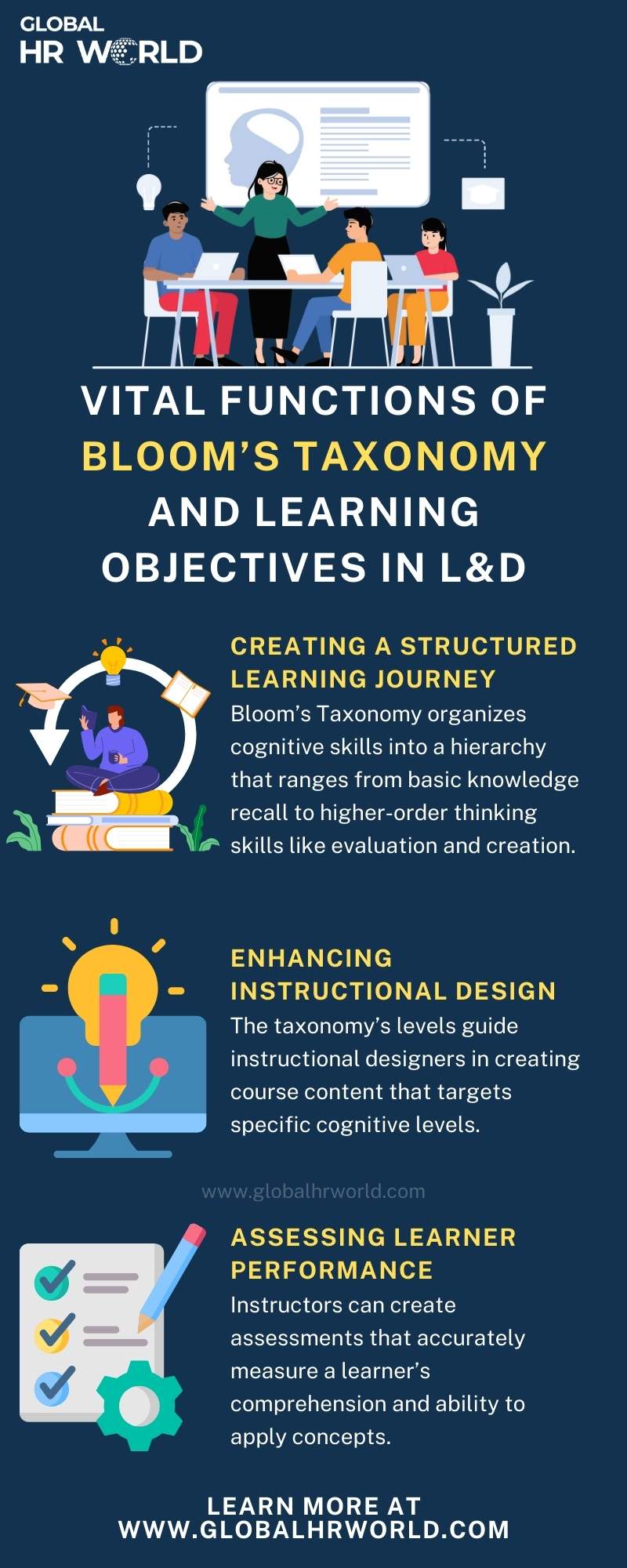Learning objectives serve as a blueprint for instructional design. Well-defined and articulated learning objectives are important because they provide learners with a clear purpose for focusing their learning efforts. But do you know the concept of learning objectives is mainly based on the work of Benjamin Bloom? The blog will discuss Bloom’s taxonomy and its relevance in corporate training.
What is Bloom’s taxonomy?
Bloom’s taxonomy is a structural classification system for defining and distinguishing different levels of human cognition, such as knowledge, comprehension, application, analysis, synthesis, and evaluation. In 1956, educational psychologist Benjamin Bloom developed a model for learning objectives in his book, The Taxonomy of Educational Objectives:
The Classification of Educational Goals (1956). Bloom set out a series of verbs for learning objectives known as Bloom’s taxonomy. The taxonomy concentrates on how people can learn effectively using a structural base. The principle here is that knowledge can change attitude; this new and acquired knowledge can then shape intention, and intentions created during learning drive behavior at work.
Any learning module can incorporate Bloom’s taxonomy to enrich the outcome. Workplace training uses this taxonomy to train employees effectively. Well-written learning objectives help employees anticipate what to expect from the training. It provides them with a structural base for learning. Instructional designers can use Bloom’s taxonomy verbs for objectives globally to define the required cognition level in eLearning to map the content type to the imagination or multimedia enablement of an eLearning course.
Now, the original framework of Bloom’s taxonomy was revised by one of Bloom’s students, Lorin Anderson, in 2001. Anderson replaced the original nouns used for each level with verbs and rearranged a few levels. According to this revised version of the taxonomy, there are six cognitive learning that we are going to discuss now.
Let us take a closer look at each learning level:
Level 1: Remember
This stage of learning is about retrieving knowledge from long-term memory like basic facts, dates, events, persons, places, concepts, and patterns. In this stage, trainees recall the steps of the training session. At this level, the instructors might ask learners simple questions in order to locate knowledge in long-term memory related to the presented material. Bloom’s taxonomy verbs for objectives to use at this stage: list, recite, outline, define, name, match, quote, recall, identify, label, recognize, etc.
Level 2: Understand
At this point, trainers might ask the trainees to explain the core concept in their own words. Interpreting means changing from one form of representation to another. It, therefore, provides a general summary. Summarizing is retrieving a general theme of significant points and finding correspondences between two ideas or objects. It constructs a cause-and-effect model of a system. Bloom’s taxonomy verbs for objectives to use at this stage: describe, explain, paraphrase, restate, give original examples, summarize, contrast, interpret, discuss, etc.
Level 3: Apply
Now, it is time to use learned facts and abstractions in new contexts and particular situations. The processes of cognition at this stage are executing and applying a procedure to a familiar task or implementing the procedure to an unfamiliar task. It implicates practicing skills in a new context. Here, the employees practically utilize the lessons of the training session. Bloom’s taxonomy verbs for objectives to use at this stage are calculate, predict, apply, solve, illustrate, use, demonstrate, determine, model, perform, present, etc.
Level 4: Analyze
At this level, learners are supposed to break down concepts and examine their relationships. The processes associated with this stage are distinguishing important from unimportant parts of presented material, identifying how elements function within a structure, and determining a point of view, bias, values, or intent underlying presented material. Bloom’s taxonomy verbs for objectives to use at this stage are classify, break down, categorize, analyze, diagram, illustrate, criticize, simplify, associate, etc.
Level 5: Evaluate
At this level, learners can use their knowledge and skills to appraise a situation, justify their stand, or criticize others’ opinions. The learners should be able to point out logical errors or compare work to the highest standards in its field. It helps to detect inconsistencies or errors in a process. The learners may also suggest changes to the training program and put forward related training topics that would be relevant to their workplace. Bloom’s taxonomy verbs for objectives to use at this stage: choose, support, determine, defend, judge, compare, contrast, argue, justify, support, convince, select, evaluate, etc.
Level 6: Create
This is the final and the most complex stage of the learning process. At this stage, learners combine known patterns, ideas, and facts to create original work or formulate their solution to a problem. At this stage, the learners develop alternative hypotheses based on criteria. Bloom’s taxonomy verbs for objectives to use at this stage are design, formulate, build, invent, create, compose, generate, derive, modify, develop, etc.
Using these abovementioned Bloom’s taxonomy verbs for objectives can help employees explicitly navigate what they must do to demonstrate mastery in their job.
How can Bloom’s taxonomy verbs for objectives aid in training design?
Benjamin Bloom’s taxonomy is a powerful tool that helps develop learning outcomes because it explains the process of learning. The verbs used in learning objectives should correspond to the level of thought the learners are expected to perform. Therefore, using Bloom’s taxonomy verbs for objectives enhances the quality of workplace training.
When organizing training programs, one can use Bloom’s taxonomy to determine what the learners are qualified to know and bring to light what the organization wants them to know. If it is a new type of skill, it will suggest operating the training gently and with a higher level of help. If, on the other hand, it is old information that the employees already know, it will suggest moving faster with the training program and include more complexity.
Therefore, Bloom’s taxonomy can evaluate the level learners are at – and where the organization wants them to be. Are the learners ready to utilize the information yet? Or will they need to learn more?
Using Bloom’s taxonomy as a guide, trainers can identify clear instructional objectives corresponding to each taxonomy level and create plans to achieve them. Bloom’s taxonomy allows instructors to gauge the trainees’ progress. It helps to determine their level and assign them an individual task.
By setting achievable objectives for the employees, instructors make them more active and responsible for their education.
Additionally, Bloom’s model can help with how to assist others. For example, suppose one of the employees is having trouble acquiring sufficient conceptual understanding. By analyzing Bloom’s taxonomy verbs for objectives, one could identify the gap and assist them in acquiring the essential knowledge they lack.
Thus, Benjamin Bloom’s taxonomy verbs for objectives influence workplace training to a different extent.
How do we use Bloom’s taxonomy verbs for objectives to create effective learning outcomes?
In order to create effective learning outcomes using Bloom’s taxonomy verbs for objectives, instructors should pay attention to a few details.
- Keep all your learning outcomes measurable, clear, and concise.
- Start each objective with a verb that describes an observable behavior, such as describe, summarize, demonstrate, compare, plan, score, etc. You can observe the audience to measure how well they met the objective.
- Make sure that there is one measurable verb in every objective. Each outcome needs one verb. Having two verbs can result in a “split” outcome, where a learner could potentially meet part but not all of the requirements.
- Ensure that the verbs for objectives in the course level outcome are at the highest level of Bloom’s taxonomy.
However, Bloom’s taxonomy verbs for objectives treat learning as sequential. However, training and learning programs are not always linear. For example, a training module can start with an evaluation-based question to increase the learners’ interest before applying.
The model also receives criticism for its hierarchal nature, which implies that specific levels are connected to each other. But learning is a sliding continuum where you can move back and forth to any level as you learn. And yet, despite all these criticisms, Bloom’s taxonomy verbs for objectives remain prevalent in the workplace for the training system. It helps us to incorporate necessary thinking in learning modules and take learning to a higher level.
Infographic

Knowledge Check!
Frequently Asked Questions (FAQs)
What is Bloom’s taxonomy in simple words?
Bloom’s taxonomy is a classification system that defines and distinguishes different levels of human cognition.
How do you write an objective verb?
Each learning objective should start with a verb that describes an observable behavior, such as describe, summarize, demonstrate, compare, plan, score, etc. You can observe the audience to measure how well they met the objective.
Can a learning objective have two verbs?
Make sure that there is one measurable verb in every objective. Each outcome needs one verb. Having two verbs can result in a “split” outcome, where a learner could potentially meet part but not all of the requirements.



